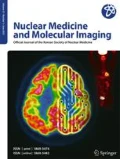In the last 2 years of my first term, I and my Associate Editors have shaped and stabilized the inflow of the submitted articles, either original or review. Specifically, the turnaround time is being shortened and the number of citations per article is rising. Online publication of accepted articles allows these articles to be browsed on the internet, especially on Google Scholar. As Nuclear Medicine and Molecular Imaging (NMMI) is a subscription journal and the articles have an embargo of 1 year before they can be freely viewed on PubMed, the availability of online published articles is not perfect. I am trying to figure out how to solve this problem, as our publisher Springer is working on a middle way between open access and subscription and as our journal is in the list of ESCI (Emerging Science Citation Index) newly introduced by Clarivate Analytics (previously Thomson Reuters).
Unfortunately, customs are slow to change with regard to the evaluation of publications of the authors who are enrolled as professors and research scientists at universities, colleges, or research institutions. That is to say, usually only articles in SCI journals, more specifically original articles, are counted. I am keenly aware of this situation and will try my best together with my Associate Editors. From this point of view, I really appreciate the efforts and contributions of editorial board members to fulfill their privileges or duties to submit review articles within their first term of 2 years. Review articles are not counted as achievements by their employing institutions, but nevertheless the editorial board members have endeavored to summarize the most recent knowledge for our readers. Let us appreciate their goodwill and efforts.
In terms of the characteristics or unique features of NMMI, it has now broadened its scope to embrace the chemistry and physics of nuclear medicine and even nanomedicine. I and the Associate Editors decided on this expansion to ensure comprehensive coverage of the field of molecular imaging. This field is governed by another recently established Society in Korea as well as in several other countries. We can recognize the names of journals dedicated to molecular imaging (SNM-affiliated, SAGE) and to molecular imaging and biology (World Molecular Imaging Society-affiliated and European Society for Molecular Imaging-affiliated, Springer). I and the Associate Editors have agreed that NMMI can open up to cover Asian efforts to promote preclinical/clinical use of molecular imaging, as well as Korean endeavors. As the first step, we are going to include eminent Korean molecular imaging clinicians as members of our editorial team. Let us welcome them.
Moreover, NMMI and its editors desire to contribute to the global community of nuclear medicine and molecular imaging. Asia is an emerging continent with more than half of the world’s population, who need to be cared for by the best nuclear medicine experts with the best nuclear medicine resources. Korea has a unique history of developing this discipline from scratch to the global level of academic achievements as well as clinical performance. According to the statistics of the World Nuclear Association (http://www.world-nuclear.org/), the USA is performing about 20 million, the EU 10 million, and Asia 5 million in vivo nuclear imaging procedures and treatments. The cream of the next generation should be educated and encouraged to achieve the global level of academic performance and quality. To this end, I asked the leaders of Asian countries to recommend their best young nuclear medicine and molecular imaging experts, and invited them to become members of the editorial team. Some of them have already served as reviewers for the past 2 years and their performance has been really excellent.
At the beginning of my second term as Editor-in-Chief of NMMI, with its genuine potential to contribute to the scientific and medical growth of our region, I feel the future will open another era of Asian nuclear medicine in many countries that can, like Korea, be described as “recently developed,” not only in terms of economy and social systems but also by virtue of enjoying the benefits of diagnosis and treatment by their own best experts in nuclear medicine and molecular imaging, globally recognized and renowned. I am confident our Chinese colleagues will excel in this respect as their economy is strong and Korea’s growth performance might be considered as benchmark for other Asian countries, including the Arab countries. Our journal’s effort will supply the opportunities for growth in the next generation and provide the milieu to dissipate evidence-based, collaborative, and scientifically sound nuclear medicine throughout the world. African, Latin American, and Balkan colleagues are also welcomed and our next step will make our journal a truly global enterprise, competent to promote nuclear medicine and molecular imaging worldwide.
I hope all the members of the editorial board, including the new invitees, have the opportunity to contribute to the growth of our discipline owing to this journal.
Author information
Authors and Affiliations
Corresponding author
Rights and permissions
About this article
Cite this article
Lee, D.S. Message from the Editor-in-Chief 2017. Nucl Med Mol Imaging 51, 1–2 (2017). https://doi.org/10.1007/s13139-017-0470-0
Published:
Issue Date:
DOI: https://doi.org/10.1007/s13139-017-0470-0

